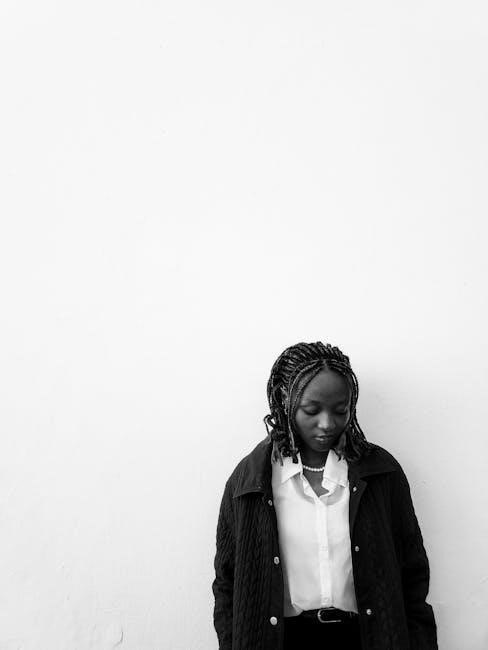Discover how to find your perfect jacket size with our comprehensive guide. Learn about proper fit, size variations, and how to choose styles that flatter your silhouette.
Understanding the Importance of Proper Fit
A well-fitting jacket enhances comfort, confidence, and style. Proper fit ensures freedom of movement and flatters your body shape. Ill-fitting jackets can restrict movement or look unflattering. Measure accurately to avoid sizes that are too tight or too loose. A correct fit boosts confidence and ensures functionality, like weather protection; Use size charts to align measurements with garment dimensions. Consider fabric stretch and weight for comfort. Reviews and guides help troubleshoot common fit issues, ensuring satisfaction. Proper fit is key to enjoying your jacket for years.
How to Use a Size Chart Effectively
To use a size chart effectively, start by taking accurate body measurements, focusing on chest, waist, and hips. Compare these to the chart, ensuring alignment with your size. Remember, sizes can vary across brands, so always refer to the specific chart provided for each product. If unsure, consider customer reviews for fit feedback. Pay attention to whether the chart lists body measurements or garment dimensions, as this affects sizing accuracy. Double-check the fit style (slim, regular, or oversized) to match your preference and body type. This approach helps minimize returns and ensures a flattering, comfortable fit.

Measuring Yourself for the Perfect Fit
Accurate measurements are key to finding your ideal jacket size. Measure your chest, waist, and hips with a flexible tape measure for precise results.
Key Measurements: Chest, Waist, and Hips
Accurate measurements of your chest, waist, and hips are essential for selecting the right jacket size. Measure your chest under the arms, around the fullest part. For the waist, find the narrowest point and wrap the tape snugly. Hips are measured around the widest section, typically 7-9 inches below the waistline. These measurements help determine your size and ensure a flattering fit. Proper alignment of buttons, seams, and sleeves depends on these dimensions. Use a flexible tape measure for the best results, ensuring the tape is level and not too tight or loose. This will guide you to your ideal jacket size.
How to Measure Accurately at Home
To ensure a perfect fit, measure yourself accurately using a flexible tape measure. Start by standing up straight and relaxing your muscles. For the chest, wrap the tape around the fullest part, keeping it level and parallel to the floor. Measure your natural waistline by bending slightly to one side to locate the narrowest point of your torso. For the hips, measure around the widest part, about 7-9 inches below your waistline. Avoid pulling the tape too tight or slouching, as this can lead to inaccurate results. Take note of these measurements and compare them to the size chart for the best fit.

Standard Women’s Jacket Size Chart
Compare UK, EU, and US sizes for a universal fit. Measure chest, waist, and hips to match your body measurements with the chart’s sizing guide precisely.
UK, EU, and US Size Comparisons
Understanding size differences across regions is key to finding the right fit. UK sizes range from 8 to 18, while EU sizes span 34 to 46, and US sizes include XS to XXL. For example, a UK size 8 corresponds to an EU 34-36 and a US XS. Similarly, a UK size 16 matches an EU 42-44 and a US XL. These comparisons help bridge regional sizing gaps, ensuring a more accurate fit. Always refer to the specific size chart for each brand, as variations may occur. This guide simplifies international size conversions, making shopping across borders easier and more confident.
Body Measurements vs. Garment Dimensions
Understanding the difference between body measurements and garment dimensions is crucial for selecting the right jacket size. Body measurements are personal and dynamic, reflecting your chest, waist, and hip sizes. Garment dimensions, however, represent the actual size of the jacket, which may vary by brand and style. Always compare your body measurements to the garment’s specifications, as sizes can differ between brands. This approach ensures a proper fit, avoiding issues like tight shoulders or excess fabric. Remember, garment dimensions are fixed, while body measurements can change, so regular measurements are essential for long-term satisfaction with your purchase.

Understanding Jacket Fit Styles
Explore various jacket styles, from slim-fit to oversized, and learn how each design caters to different body types, lifestyles, and personal preferences for optimal comfort and aesthetics.
Slim Fit, Regular Fit, and Oversized Styles
A slim-fit jacket is tailored to hug your body, creating a sleek, modern silhouette. Ideal for petite frames or those preferring a structured look. Regular fit offers a classic, versatile style with a bit more ease, suiting most body types. Oversized jackets provide a relaxed, trendy feel, perfect for layering or casual wear. Consider your lifestyle and personal style when choosing between these options. Slim fit accentuates curves, while oversized offers comfort and a fashionable edge. Each style caters to different preferences, ensuring a flattering fit for every woman. Your choice depends on desired comfort, appearance, and how you want the jacket to drape on your body.
Choosing the Right Length for Your Body Type
The right jacket length enhances your proportions and style. For petite frames, shorter jackets elongate the torso and balance proportions. Average heights can opt for mid-length styles, while taller women can carry longer jackets effortlessly. Consider your body shape: pear-shaped bodies benefit from jackets that hit above the hips, while hourglass figures look stunning in tailored, waist-defining styles. Rectangular body types can add curves with asymmetrical hemlines. Ensure the jacket complements your proportions without overwhelming your frame, creating a balanced, polished look.

Fabric and Material Considerations
Fabric weight and stretch significantly impact sizing. Heavier materials may require a larger size, while stretchy fabrics offer flexibility. Choose materials that suit your activity and style.
How Fabric Weight and Stretch Affect Sizing
Fabric weight and stretch significantly impact jacket sizing. Heavier fabrics, like thick wool or denim, may require a larger size to accommodate bulk, while lightweight materials drape differently. Stretchy fabrics, such as spandex blends, offer flexibility, allowing jackets to fit snugly without constriction. Non-stretch fabrics, however, rely solely on accurate measurements for a proper fit. Understanding these properties helps in selecting the right size, ensuring comfort and a flattering silhouette. Always consider fabric type when choosing a jacket size for the best fit.
Common Fit Issues and Solutions
Address common fit issues like tight shoulders or gapping waistlines. Adjust sizing or opt for styles with adjustable features to ensure a flattering, comfortable fit.
Troubleshooting Shoulder, Chest, and Waist Fit
Ensuring a jacket fits perfectly around the shoulders, chest, and waist is crucial for comfort and style. If the shoulders feel too tight, consider a larger size or a relaxed fit. For loose shoulders, opt for a tailored or slim-fit style. Check the chest fit by ensuring buttons lie flat; if gaping, size down. Measure your natural waist to avoid jackets that are overly tight or boxy. Adjustments in fabric choice, such as stretch materials, can also improve fit. Pay attention to body proportions, like longer torsos needing extended lengths. Accurate measurements and size charts are key to resolving common fit issues.
Brand-Specific Sizing Variations
Brands often have unique sizing standards, so the same person may be different sizes across labels. Always check the specific size chart for accurate fit.
Why Sizes Differ Across Brands
Brands often have unique sizing standards due to differences in measurement methods, fabric types, and design approaches. Some brands cater to specific body types or follow regional size trends, leading to variations. For example, one brand might offer a more relaxed fit, while another focuses on a slim, tailored look. Fabric weight and stretch can also impact how sizes fit, as materials with elasticity may sizing feel different. Additionally, some brands use body measurements, while others base sizes on garment dimensions. These factors make it essential to consult each brand’s size chart for accurate fit.
Customer reviews and feedback often highlight these discrepancies, helping shoppers adjust their expectations. Always check brand-specific guides to ensure the best fit for your body type and personal style.
Customer Reviews and Fit Feedback
Customer reviews offer valuable insights into jacket fit and sizing accuracy. Check feedback for sizing tips and compare measurements to ensure the best fit for your body type.
Using Reviews to Guide Your Size Selection
Customer reviews are invaluable when choosing your jacket size. Many reviewers share insights about fit, helping you avoid sizing mishaps. Look for mentions of how the jacket runs—whether it’s true to size, small, or large. Pay attention to comments about specific measurements, body types, and fabric stretch. For instance, if multiple reviewers with your body type find the jacket fits perfectly, you can feel more confident in your choice. Reading reviews also highlights common issues, like tight shoulders or gaps at the waist, guiding you to adjust your size selection accordingly. This feedback ensures a better fit tailored to your needs.

Final Tips for Choosing the Right Jacket
Combine accurate measurements with style preferences and fabric considerations to ensure a jacket that offers both comfort and a flattering fit for years to come.
Combining Measurements, Fit Style, and Personal Preference
When selecting a jacket, it’s essential to blend accurate measurements, desired fit styles, and personal taste. Use your chest, waist, and hip measurements to align with size charts, ensuring a precise fit. Consider whether you prefer slim, regular, or oversized styles, as this impacts comfort and aesthetics. Personal preference also plays a role—choose fabrics, lengths, and designs that suit your lifestyle and body type. By harmonizing these elements, you’ll find a jacket that not only fits well but also reflects your unique style and meets your practical needs, ensuring long-term satisfaction with your purchase.
Ensure long-term satisfaction with your jacket purchase by combining proper fit, accurate measurements, and style preferences. This guide helps you make informed choices for a perfect fit.
Ensuring Long-Term Satisfaction with Your Jacket Purchase
To ensure long-term satisfaction with your jacket purchase, consider factors beyond size, such as fabric quality, durability, and personal style preferences. Always review customer feedback to gauge real-world fit and comfort. Pay attention to garment care instructions to maintain your jacket’s shape and material integrity. By combining accurate measurements, understanding fit styles, and prioritizing quality, you can enjoy a jacket that remains a wardrobe favorite for years. Remember, the right fit and feel are investments in both comfort and confidence.



